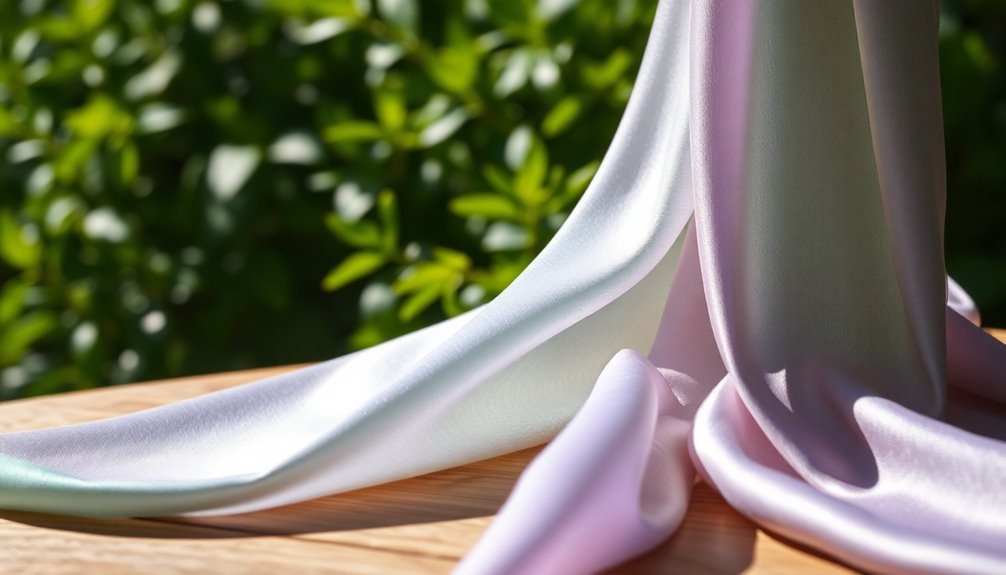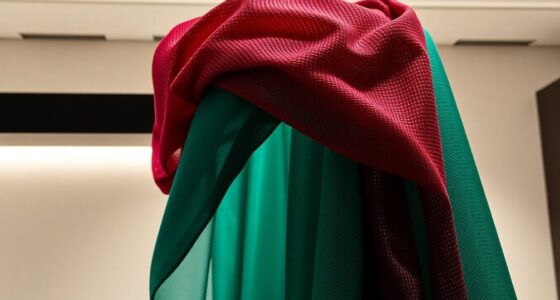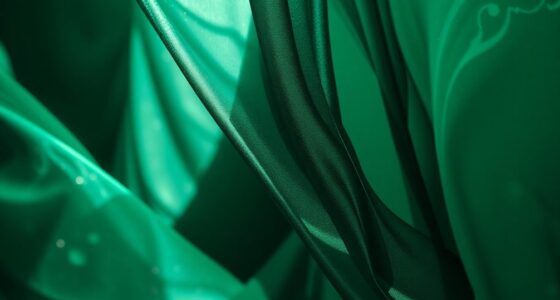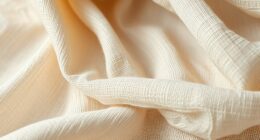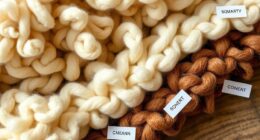Eco silk is revolutionizing the fashion world by providing a luxurious yet sustainable alternative to traditional silk. It's created using methods that prioritize the welfare of silkworms and the environment. With lower greenhouse gas emissions and natural dyes that reduce water pollution, eco silk is a smart choice for the mindful consumer. Plus, it supports local economies through fair practices and community development. Stick around to discover how you can add eco silk to your wardrobe!
Key Takeaways
- Eco silk provides a sustainable alternative to traditional silk, minimizing harm to silkworms through methods like Peace Silk and Ahimsa Silk.
- The production of eco silk reduces greenhouse gas emissions by up to 40% and uses significantly less water than conventional silk.
- Ethical certifications like GOTS and Fair Trade ensure fair labor practices and transparency in eco silk production, aligning with consumer values.
- Natural dyes used in eco silk reduce water pollution, supporting local economies and promoting sustainable dyeing techniques.
- Eco silk empowers local communities, particularly women, by creating fair trade jobs and fostering sustainable livelihoods in rural areas.
What Is Eco Silk?
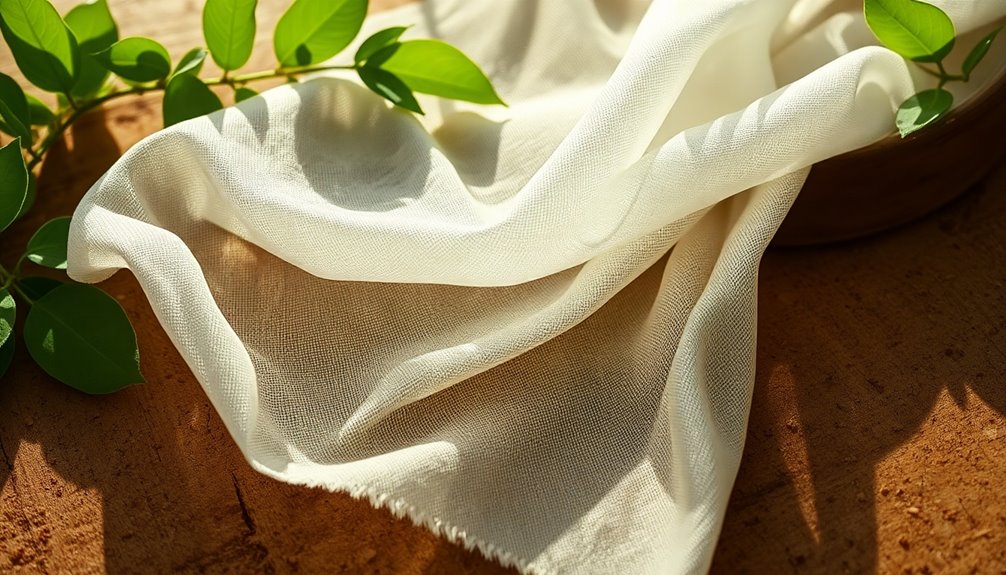
Eco silk is a revolutionary fabric that offers a sustainable alternative to traditional silk. Unlike conventional silk, eco silk is often produced using methods that minimize harm to silkworms, such as Peace Silk, which allows moths to exit their cocoons before processing. This approach notably reduces its environmental impact.
Additionally, eco silk typically involves lower greenhouse gas emissions, making it a more eco-friendly choice. You'll also find that eco silk can be dyed with natural dyes, avoiding the harmful runoff associated with synthetic dyes.
The Environmental Benefits of Eco Silk
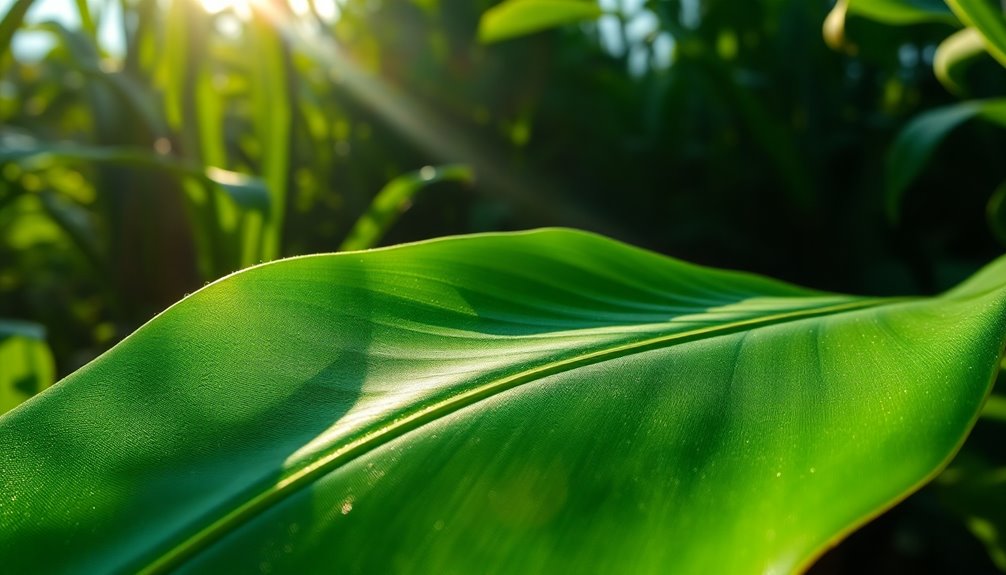
When you choose eco silk, you're not just opting for a beautiful fabric; you're supporting a more sustainable future.
This fabric cuts down on greenhouse gas emissions and uses far less water than traditional silk.
Plus, its ethical production practices promote biodiversity and respect for nature, making it a smart choice for the environment.
Reduced Water Consumption
Silk production traditionally requires significant water resources, but with eco silk, you can enjoy this luxurious fabric while supporting sustainable practices.
Eco silk, particularly Eri silk, dramatically reduces water consumption, needing less than 10 inches of rainfall annually compared to conventional mulberry silk, which relies heavily on irrigation.
By cultivating plants like castor leaves for Eri silk, farmers use less water overall, promoting improved water conservation in agriculture.
Additionally, the natural dyes used in eco silk processes minimize harmful runoff, protecting aquatic ecosystems from pollution.
Lower Greenhouse Gas Emissions
Choosing eco silk not only promotes responsible water use but also plays a notable role in reducing greenhouse gas emissions. By opting for eco silk, you're embracing sustainable practices that result in up to 40% lower greenhouse gas emissions compared to traditional mulberry silk.
This reduction comes from using drought-resistant crops and natural dyes, which considerably lessen the overall environmental impact. Additionally, eco silk production requires less water and energy, further shrinking the carbon footprint of fabric manufacturing. Furthermore, this eco-friendly approach aligns with renewable energy initiatives, contributing to a broader movement towards sustainability.
Ethical Production Practices
While many fabrics contribute to ethical dilemmas in production, eco silk stands out for its commitment to humane practices. By utilizing methods like Eri silk, eco silk allows silkworms to complete their life cycle, greatly reducing ethical concerns.
This sustainable approach not only promotes animal welfare but also results in 40% lower greenhouse gas emissions compared to traditional silk due to drought-resistant castor leaves.
The use of natural dyes in eco silk production minimizes harmful chemical runoff, protecting aquatic ecosystems. Additionally, ethical production practices promote fair labor conditions, supporting artisans in rural communities.
Finally, eco silk is biodegradable, contributing to lower environmental impacts at the end of its life cycle—unlike synthetic fabrics that can linger for centuries.
Ethical Production Practices in Eco Silk

When you choose eco silk, you're supporting fair labor practices that guarantee artisans are paid fairly for their skills.
The use of natural dyes not only protects the environment but also assures vibrant colors without harmful runoff.
Plus, sustainable sourcing methods contribute to a more responsible fabric production, making your choice even more impactful.
Fair Labor Practices
Eco silk production stands out for its commitment to fair labor practices, ensuring that artisans aren't only compensated fairly but also supported in their communities.
By focusing on Eri silk, these co-ops allow silkworms to complete their life cycles, addressing ethical concerns linked to traditional silk methods. This approach promotes sustainable livelihoods, enabling artisans to earn fair wages while fostering community development in rural areas.
Furthermore, ethical sourcing and transparency in the supply chain are essential to Eco silk, actively combating human rights abuses often found in conventional silk production.
When you choose Eco silk, you're not just investing in a luxurious fabric; you're also supporting fair labor practices that uplift communities and create a more just textile industry.
Natural Dye Usage
Natural dyes play an essential role in Eco silk production, offering an environmentally friendly alternative to synthetic dyes. By opting for natural dyeing methods, you contribute to ethical production practices that prioritize sustainability.
Here's why natural dyes are a great choice:
- Reduced Water Pollution: Natural dyes have lower toxicity levels, which means they're less harmful to our water systems.
- Support for Local Economies: Many natural dyeing techniques are labor-intensive and support traditional craftsmanship, enriching local communities.
- Skin-Friendly: Dyes like indigo and madder root provide vibrant colors and are less irritating to the skin.
Choosing eco silk dyed with natural substances not only enhances your wardrobe but also champions environmental and ethical production practices. Additionally, natural dyeing methods often utilize sustainable materials that further minimize the environmental impact of fabric production.
Sustainable Sourcing Methods
Sustainable sourcing methods in silk production not only protect the environment but also assure the well-being of silkworms and local communities. By using ethical practices like Peace Silk, you allow silkworms to complete their life cycle. Eri silk, created from drought-resistant castor leaves, supports women-run co-ops, enhancing both environmental and social sustainability.
| Sourcing Method | Benefits |
|---|---|
| Peace Silk | Assures silkworm welfare |
| Eri Silk | Promotes women's co-ops |
| Natural Dyes | Reduces harmful runoff |
| Fair Labor Practices | Supports local economies |
These sustainable sourcing methods lower the environmental impact of eco silk production, achieving up to 40% fewer greenhouse gas emissions than conventional methods. Embracing eco silk means choosing a fabric that's kind to the planet and its people.
The Impact of Eco Silk on Local Communities
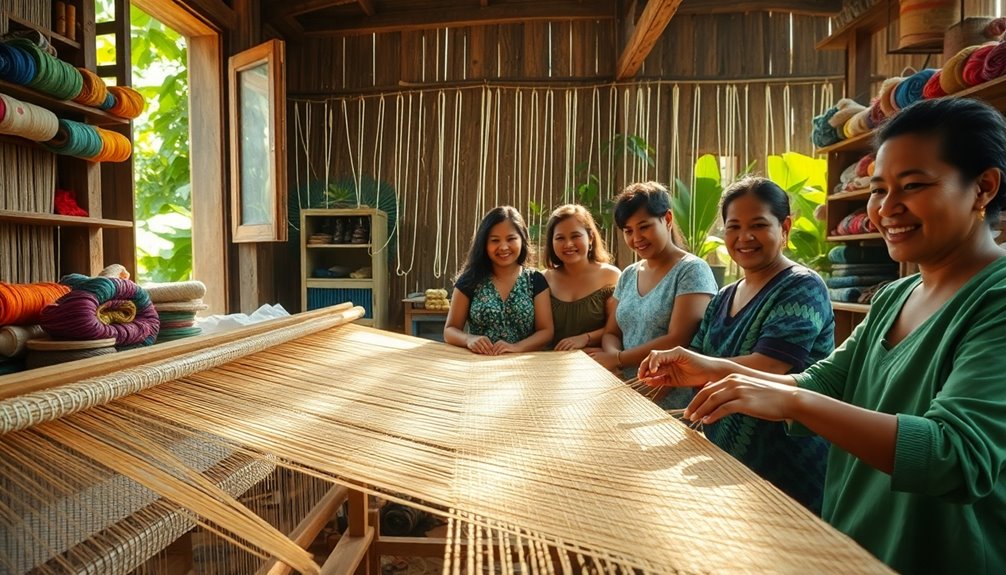
As communities embrace the production of eco silk, they reveal opportunities for economic growth and empowerment. This sustainable fabric not only supports local economies but also fosters sustainable livelihoods.
Here are some key impacts of eco silk on local communities:
- Women's Empowerment: Many eco silk cooperatives are women-owned, providing women with economic independence and leadership roles.
- Job Creation: The production of eco silk creates job opportunities, helping to alleviate poverty and stimulate local economies.
- Resource Efficiency: Utilizing drought-resistant castor leaves, eco silk cultivation requires less water, benefiting arid regions facing water scarcity.
Comparison of Traditional Silk and Eco Silk

When choosing between traditional silk and eco silk, you'll find distinct differences that greatly impact the environment and ethical practices.
Traditional silk production often relies on methods that involve boiling silkworms alive, while eco silk, like Eri or Peace Silk, allows them to complete their life cycle.
Additionally, producing one kilogram of traditional silk requires about 187 kg of mulberry leaves, leading to significant land use. In contrast, eco silk uses drought-resistant plants, resulting in 40% lower greenhouse gas emissions.
Moreover, traditional silk is frequently processed with chemicals that pollute water, whereas eco silk favors natural dyes, minimizing harmful runoff.
Finally, eco silk supports fair labor practices through cooperatives, unlike many conventional operations.
Types of Eco Silk: Peace Silk, Tussah, and Ahimsa Silk
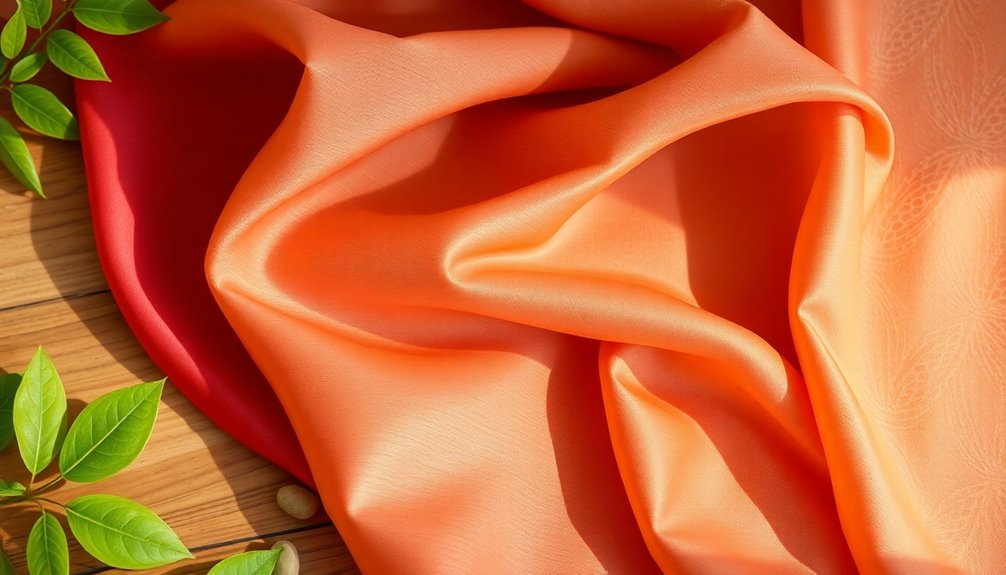
While many people associate silk with luxury, eco silk offers a compassionate and environmentally friendly alternative.
You'll find three main types of eco silk that stand out:
- Peace Silk: This allows silkworms to complete their life cycle, resulting in 40% lower greenhouse gas emissions compared to traditional silk.
- Tussah Silk: Sourced from wild silkworms in forests, it requires less intensive farming and has a coarser texture with an earthy color.
- Ahimsa Silk: Known as "non-violent silk," it guarantees silkworms aren't killed during production, aligning with cruelty-free principles.
All three types minimize environmental impact by reducing water consumption, avoiding harmful chemicals, and supporting sustainable farming practices, making them perfect choices for eco-conscious consumers.
The Role of Certifications in Sustainable Silk
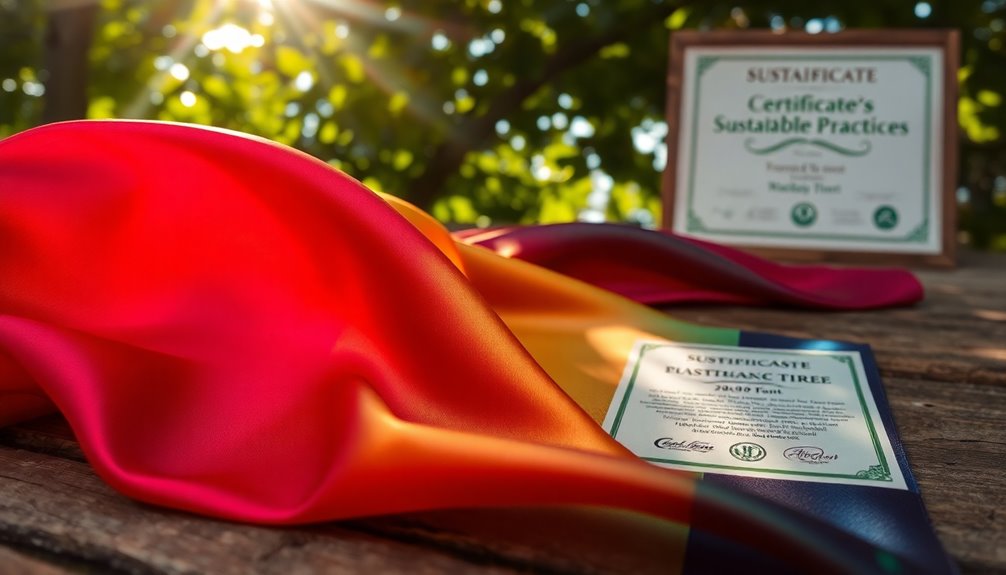
When you choose silk, understanding certifications can make a big difference.
Ethical certifications like GOTS and Fair Trade help you recognize sustainable practices and guarantee that both the environment and workers are treated fairly.
Importance of Ethical Certifications
In today's world, consumers often seek out products that align with their values, and ethical certifications play an essential role in identifying sustainable silk.
These certifications guarantee that silk is produced responsibly, benefiting both the environment and communities involved in the silk industry.
Here are three key reasons why ethical certifications matter:
- Animal Welfare: Certifications like Peace Silk allow silkworms to complete their life cycle before fibers are harvested.
- Transparency in Supply Chains: They enable you to make informed choices, supporting brands committed to ethical sourcing practices.
- Sustainable Practices: Organizations like the Textile Exchange promote methods that reduce greenhouse gas emissions and improve livelihoods in sericulture. Additionally, the demand for smart home technology is increasing, reflecting a broader consumer trend towards sustainability and efficiency.
Recognizing Sustainable Practices
Recognizing sustainable practices in the silk industry is essential for making informed choices, especially as more brands seek to align with eco-conscious values.
Certifications play a significant role in identifying truly sustainable silk. The Global Organic Textile Standard (GOTS) guarantees silk is produced from organic sources, free from harmful chemicals, and follows strict environmental and social criteria.
The Responsible Silk Standard (RSS) highlights ethical labor practices, focusing on worker welfare and environmental stewardship.
Additionally, OEKO-TEX Standard 100 assures that your silk products are free from harmful substances, promoting safety for you and the planet.
Innovations in Eco Silk Production
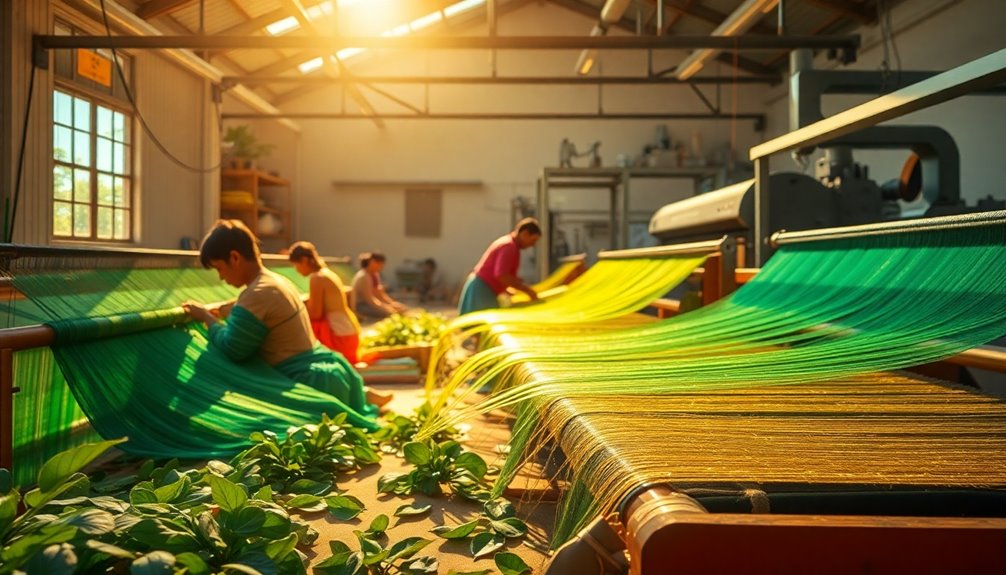
As the fashion industry increasingly embraces sustainability, innovations in eco silk production are paving the way for a greener future.
You'll find that eco silk, like Eri silk, allows silkworms to complete their life cycle, cutting greenhouse gas emissions by 40%.
Here are some key advancements:
- Sustainable harvesting methods that reduce water consumption and harmful runoff.
- Natural dyes that enhance the fabric's beauty while minimizing environmental impact.
- Cruelty-free solutions, such as Peace Silk, where moths exit their cocoons before processing.
Additionally, the closed-loop production recycles 99.6% of solvents, ensuring minimal waste.
How to Incorporate Eco Silk Into Your Wardrobe
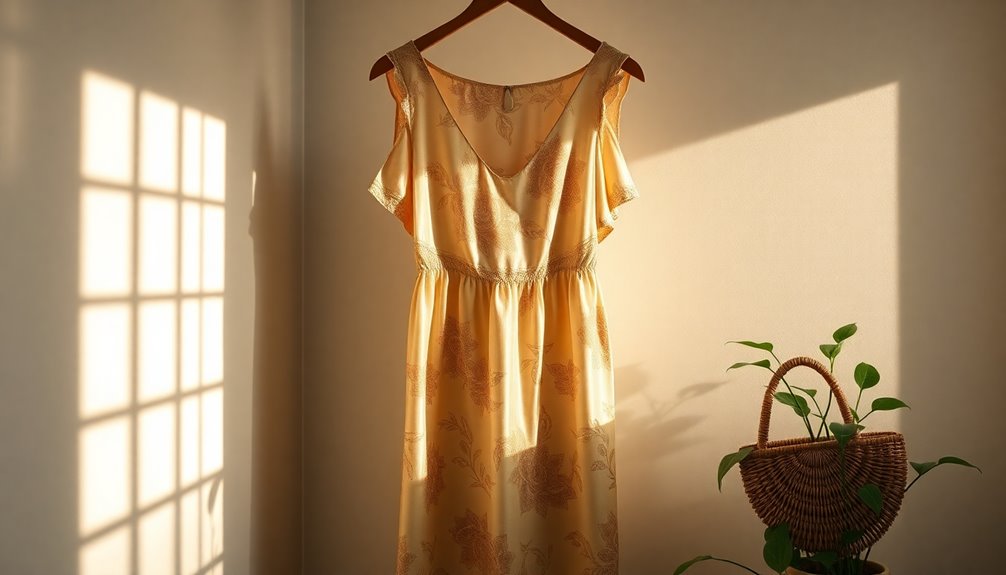
Incorporating eco silk into your wardrobe not only elevates your style but also aligns your fashion choices with sustainable practices.
Start by choosing pieces made from eco silk, like Eri or Peace silk, which allow silkworms to complete their life cycle, reducing ethical concerns. Look for garments dyed with natural dyes to minimize harmful runoff, ensuring your fashion choices are environmentally friendly.
Investing in high-quality eco silk means you'll enjoy durable items that last for years, contributing to a more sustainable cycle. Support brands that prioritize transparency in their supply chains, allowing you to back ethical labor practices and uplift local artisan communities.
With these choices, you can enjoy luxurious style while making a positive impact.
The Future of Eco Silk in Sustainable Fashion
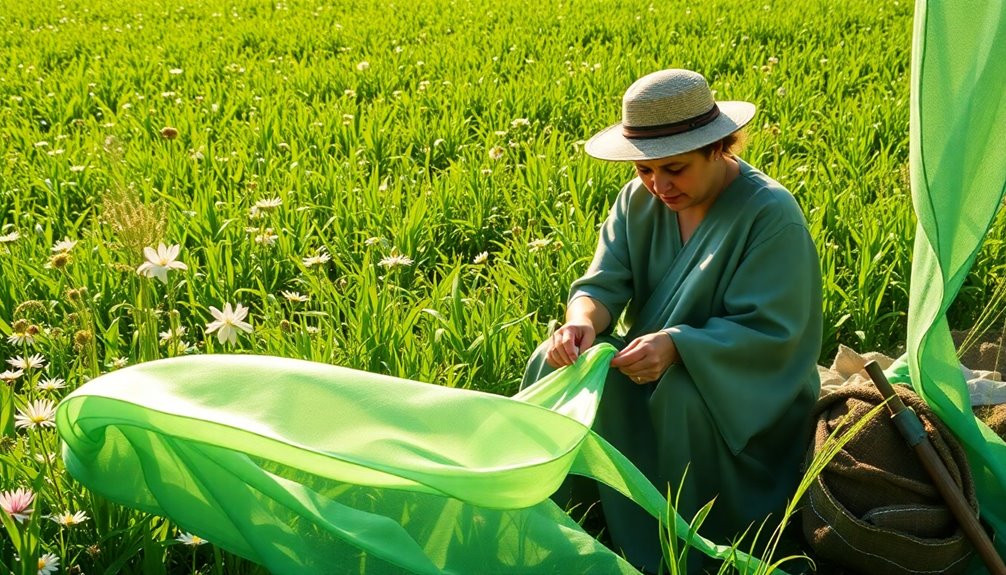
With the rising awareness of environmental issues, eco silk is carving out a significant niche in sustainable fashion.
As you explore this innovative fabric, consider its potential benefits:
- Lower Environmental Impact: Eri silk reduces greenhouse gas emissions by 40% compared to traditional silk, making it a smarter choice for the planet.
- Ethical Production: Eco silk allows silkworms to complete their life cycles, addressing ethical concerns linked to conventional silk farming.
- Support for Local Economies: Many eco silk initiatives prioritize fair trade practices, fostering community development and artisan craftsmanship.
As consumer demand for sustainable fashion continues to grow, eco silk stands out as an elegant yet environmentally conscious option, merging luxury with responsibility in your wardrobe choices.
Frequently Asked Questions
What Is Eco Silk Fabric?
Eco silk fabric is a sustainable alternative to traditional silk, made through environmentally friendly methods. It often allows silkworms to complete their life cycle before harvesting, minimizing harm to these creatures.
You'll find that eco silk comes from Eri silkworms, which feed on drought-resistant plants, leading to lower emissions. This fabric is biodegradable, uses fewer chemicals, and supports ethical labor practices, making it a great choice for conscious consumers like you.
What Is the Environmental Impact of Silk Fabric?
Silk fabric has a significant environmental impact due to its traditional production methods. It requires large amounts of mulberry leaves, which affects land use and biodiversity.
The energy-intensive processes often rely on fossil fuels, increasing greenhouse gas emissions. Additionally, ethical concerns arise from labor practices and the treatment of silkworms.
What Is a Sustainable Silk Like Fabric?
Imagine wearing a cloud that's both luxurious and kind to the Earth!
Sustainable silk-like fabrics, such as Peace Silk and Eri silk, let you enjoy elegance while respecting nature. These fabrics are produced with minimal environmental impact, using ethical practices and resources like drought-resistant plants.
Alternatives like TENCEL Lyocell and modal offer softness and breathability, all while reducing waste and conserving water.
You can make a stylish choice that's also planet-friendly!
What Does It Mean to Be Sustainable Silk?
Being sustainable silk means prioritizing ethical practices in silk production.
You're looking for methods that allow silkworms to thrive, such as Peace Silk, where moths are allowed to emerge from their cocoons.
Sustainable silk also involves using natural dyes, supporting fair labor practices, and minimizing environmental impact through reduced greenhouse gas emissions.
Conclusion
As you embrace eco silk, think of it as a gentle breeze that carries the promise of a more sustainable future. By choosing this fabric, you're not just enhancing your wardrobe; you're weaving a tapestry of ethical choices that support the environment and local communities. Together, we can turn the tide in fashion, ensuring that every thread contributes to a healthier planet. So, let eco silk be your guiding light toward a more conscious lifestyle.
